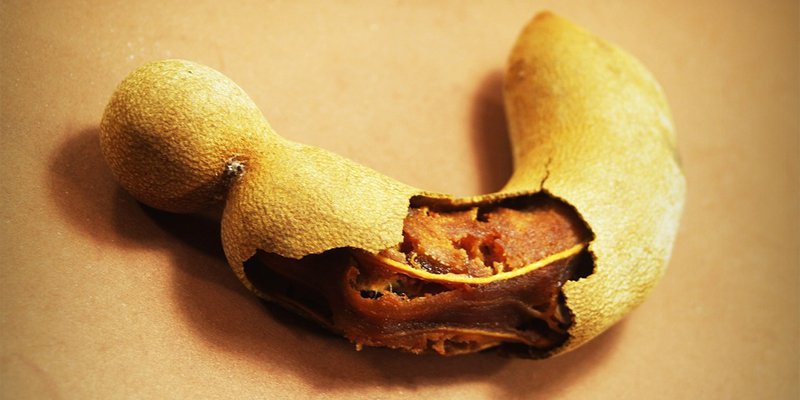If you enjoy a sweet, tangy and sour fruit, tamarind is the fruit for you. Tamarind is great for cooking to add flavor or it can be eaten when it’s ripe. Tamarind doesn’t usually last long once it’s harvested. Therefore, some people will wonder how long they can last and what to do to preserve the freshness.
So how long does tamarind last? In the fridge, they will last for at least 3 months. Storing them in the freezer, tamarinds will last indefinitely. If you store them at room temperature, they may last up to a week, depending on how hot it is. The warmer it is the faster it will ripen.
There are many forms of tamarind available that include whole pods, tamarind paste, compressed tamarind, and tamarind syrup. In this short article, we’ll be discussing whole tamarind pods only. If you want to know how long they last, how to store them, and how to tell when they are bad, keep reading.
How Long Does Tamarind Last?
Tamarinds that are stored at room temperature will last for about a week once it’s harvested. Therefore, they should be consumed or used for cooking within a week. After a week, they are still safe to eat, but the freshness of the tamarind will decrease. If they haven’t spoiled yet, you can move them to the fridge which will extend their shelf life.
In the fridge, it will last for about 3 months if it’s stored properly. They should always be stored in an airtight container or a resealable plastic bag where no moisture can get to it. If moisture is able to get to the tamarind, they will start to go bad.
The freezer will be the best place to store them for indefinite shelf life. As long as they remain frozen, the whole tamarind will last for many years. However, even though they can last for a very long time, the quality of the tamarind will start to decrease after about a year or so. After many years, they are safe to eat and use for cooking, but you may notice the taste is a bit different.
Therefore, after a year, break a piece of the tamarind and taste it for quality. If they seem to taste fine, you can continue to keep them in the freezer. If it tastes differently, it’s best to throw all of them out and freeze a new batch of tamarind pods.
How To Store Tamarind
Tamarind that is stored at room temperature will usually not last long. Depending on when it was harvested and how warm it is, the shelf life of the tamarind can be shortened. The warmer it is, the faster they will start to ripen. Therefore, to keep them fresh, put them in an airtight container and seal it tight with the lid.
Besides the airtight container, you can always keep them on the countertop of the kitchen without covering it. The shell of tamarind will help keep the flesh inside fresh. If the tamarind hasn’t cracked or opened by itself, it means it hasn’t ripened yet. Once the shell has cracked, you’ll either need to consume it within a couple of days or store it in the fridge.
The fridge is the place to store tamarinds if you are going to consume or use it for cooking within 3 months. To store them, simply put them in an airtight container or a resealable plastic bag. If you’re a container, make sure not to put too many in there where it will crush each other over time.
If you’re using a resealable bag to store them, it’s best to put just enough tamarinds in there that will allow you to easily seal the bag. Additionally, before sealing the bag, press on the bag to remove as much air as possible from it first.
Can You Freeze Tamarind?
The whole tamarind can be frozen easily in the freezer. Tamarinds stored in the freezer can last indefinitely and still retain their freshness after many years. However, you’ll need to freeze the tamarinds at their correct harvesting stage to achieve that freshness after so many years in the freezer.
To keep them fresh for a long time, freeze only unripened tamarinds. Tamarinds that haven’t ripened yet will have no crack on the shell. Also, the shell will be green if you scratch off the top coating of the tamarind.
If you freeze a ripened or a shell that has cracked, it could get freezer burn which will shorten their shelf life. The shell is very important as it will protect the tamarind from the freezer burn and prevent moisture and air from getting to the flesh.
By storing them properly, frozen tamarind is not only great to eat right out of the shell, but it can be used for cooking, making drinks, and making tasty desserts.
If you’re planning to eat them, let it thaw on the counter for about an hour and you’ll have a delicious sweet and sour snack. For cooking, making drinks and desserts, simply drop the frozen tamarind into the skillet or blender.
How To Freeze Tamarind
Freezing the whole tamarind pod is simple and it doesn’t take that much time. Below is how to prepare tamarinds to be frozen in the freezer:
- Pick tamarinds that haven’t ripe yet. Unripe tamarinds will have no cracks along the shell and it will be green if you make a scratch on it. Besides unripe tamarind, you can freeze riped one as well. However, riped tamarinds will not last as long as unripened tamarind in the freezer.
- Grab an airtight container or a resealable freezer bag.
- Clean the container or bag thoroughly to remove any dirt and contaminants that might be in there.
- Put the tamarind into the container or bag. Put enough where they won’t be too cramped.
- For containers, make sure to seal the lid as tight as possible. If you’re using a bag, squeeze or press the bag to remove any excess air.
- Label the container or bag and move it to the freezer.
If you need to thaw frozen tamarind, simply take them out from the freezer and leave them on the countertop at room temperature. If you froze unripened tamarinds, you’ll need to leave them out for a couple of days so they can ripe.
For frozen riped tamarinds, after it thaws after a couple of hours, you can eat it or use it for cooking.
How To Tell If Tamarind Is Bad?
When tamarind goes bad, it’s quite simple to tell. The signs that they are bad will be the texture and taste of it.
As for texture, tamarind that is bad or about to go bad will have hardened flesh inside. Good quality tamarind will have flesh that’s soft when it’s touched. When it’s bad, the flesh will become hard and shrink in size. The seeds of the tamarind will be exposed as well.
For the taste, when it goes bad, it will not have any flavor to it. It will just have a bland taste and chewy. However, the tamarind is still safe to eat or cook with, but it will not be flavorful. If you’re looking for that sweet and sour flavor, the tamarind is past its prime and should just be thrown away.
If you noticed any of the signs above, it’s best to just throw them out as the flavor of it has already diminished.
How To Keep Tamarind Fresh Longer
The key to keeping them fresh longer is to prevent the shell of the tamarind from cracking. Once the shell cracks, the flesh will start to go bad. After it’s picked from the tree, the tamarind will start to ripen, especially when the air temperature is hot.
Related Questions
Why are salt and tamarind kept together?
The flesh of the tamarind is very sticky and it will be difficult to handle. Therefore, the salt is to simply help loosen the tamarind so it will be easier to handle and won’t stick to your hand.
Can I eat tamarind seeds?
Tamarin seeds are edible and you can definitely eat them. However, you’ll need to soak them first and then roast them before you can eat them. Eating the seeds right out of the shell will be bitter and not very tasty.



